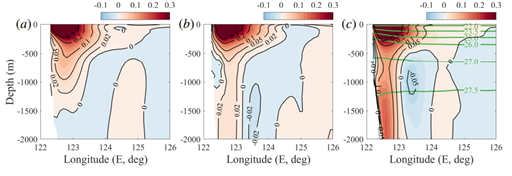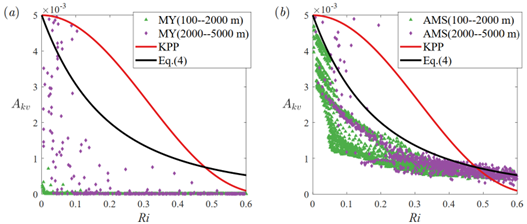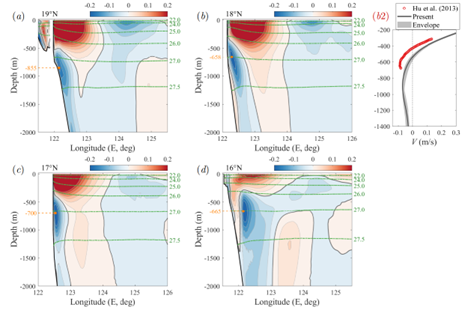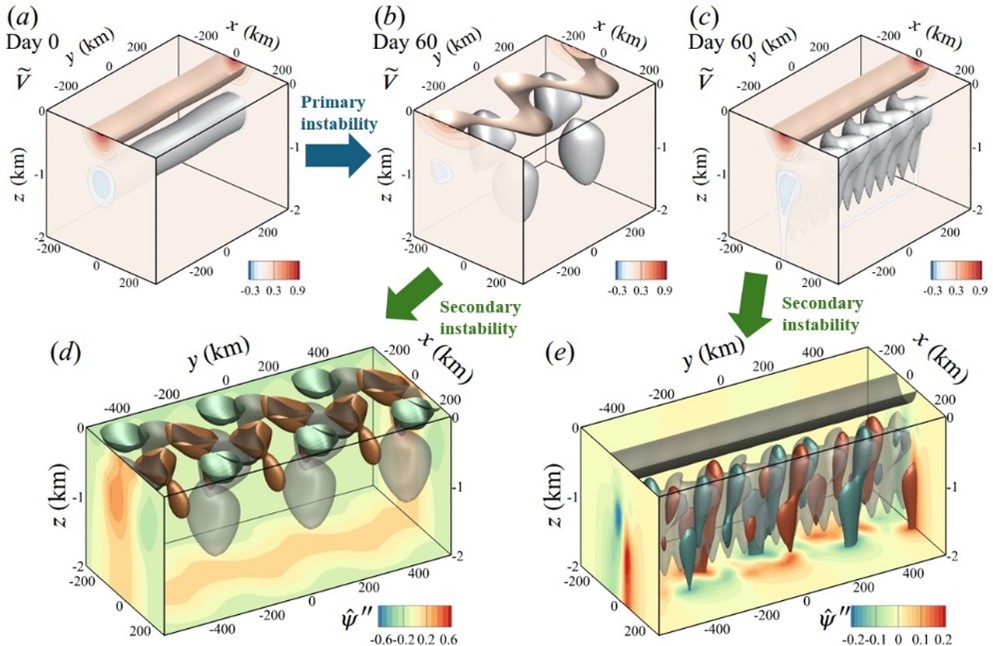Recently, Professor Jianping Gan's team at the Hong Kong University of Science and Technology has made a series of progress in the dynamic mechanism and parameterization of the Western North Pacific (WNP) Undercurrents. An unresolved problem is that the Luzon Undercurrent (LUC), a representative western boundary undercurrent in the WNP, cannot be reasonably simulated in prevailing global and regional oceanic models. Focusing on this problem, the team designed an adaptive vertical mixing parameterization scheme (AMS) based on physical reasonings and high-resolution (3km grid) China Sea Multiscale Simulation System (CMOMS, https://odmp.hkust.edu.hk/cmoms/) experiments. By introducing a Munk-like scheme in the subsurface region, the vertical mixing intensity in the low Richardson number region is enhanced, thereby well capturing the LUC. The distribution characteristics and seasonal variability of the undercurrent are consistent with observations. Meanwhile, using this undercurrent system as a model problem, the team established a nonlinear and secondary instability analysis framework for fully three-dimensional oceanic systems, revealing a new mechanism that the strong spatiotemporal variation and strong ageostrophy of the undercurrent can be explained by nonlinear stability. This work has enhanced the physical understanding of the dynamic processes of the current-undercurrent system, improved the numerical capabilities of the multi-layer circulations in the WNP, and laid a foundation for further research on biogeochemical processes in this region.
It is wildly known that the North Equatorial Current-Kuroshio-Mindanao Current (NKM) circulation system in the Western North Pacific (WNP) plays an important role in global ocean circulations and climate change. In the deeper layer (500-2000m) below the NKM circulation, there is also an undercurrent circulation system NKMU flowing in the opposite direction from the upper layer, which is mainly composed of the North Equatorial Undercurrent (NEUC), Luzon Undercurrent (LUC) and Mindanao Undercurrent (MUC) (see Figure 1). Compared with the upper-layer circulation, this undercurrent circulation system has received less attention, but it plays an important role in the subsurface transport of mass and energy and in the interaction between the equatorial and subtropical circulations.


 Fig 1 Illustration of the surface and subsurface circulations in the Western North Pacific. The upper-layer circulation (0-500m) is composed of the North Equatorial Current (NEC), Kuroshio (KC) and Mindanao Current (MC), and the subsurface circulation (500-2000m) comprises the North Equatorial Undercurrent (NEUC), Luzon Undercurrent (LUC) and Mindanao Current (MUC)
Fig 1 Illustration of the surface and subsurface circulations in the Western North Pacific. The upper-layer circulation (0-500m) is composed of the North Equatorial Current (NEC), Kuroshio (KC) and Mindanao Current (MC), and the subsurface circulation (500-2000m) comprises the North Equatorial Undercurrent (NEUC), Luzon Undercurrent (LUC) and Mindanao Current (MUC)
Currently, a number of observations have revealed the basic characteristics of the undercurrent system, but their dynamics has not been fully understood, which directly affects the numerical ability to simulate it. Taking the LUC as an example, prevailing global models HYCOM and OFES, as well as regional models like the CMOMS (developed by Professor Gan's team; before modification), have not well captured the LUC (see Figure 2).
 Fig 2 Average zonal velocity (m/s) at 18°N obtained by global and regional models: (a) OFES; (b) HYCOM; (c) CMOMS (before improvement). No southward (negative velocity) Luzon Undercurrent (velocity ~-0.1m/s) is obtained below the surface northward Kuroshio.
Fig 2 Average zonal velocity (m/s) at 18°N obtained by global and regional models: (a) OFES; (b) HYCOM; (c) CMOMS (before improvement). No southward (negative velocity) Luzon Undercurrent (velocity ~-0.1m/s) is obtained below the surface northward Kuroshio.
Professor Gan's team aimed to improve the modelling based on CMOMS, with special focus on the vertical mixing process. To compensate the deficiency of the Mellor-Yamada scheme used in the benchmark CMOMS, which underestimates the eddy diffusion coefficient in the low Richardson number region below the mixing layer, an adaptive vertical mixing parameterization scheme (AMS) was designed based on the Munk-like scheme to enhance the vertical mixing in the low Richardson number region (see Figure 3). The AMS was also shown to perform better than the KPP. After employing the AMS, the LUC was reasonably captured, and its intensity and seasonal variation are consistent with the results from direct measurements (see Figure 4). Furthermore, the dynamics of the LUC was studied through a momentum balance analysis. It was found that the LUC was mainly maintained by the baroclinic pressure gradient force caused by the strong thermocline tilting near the western boundary. In addition, nonlinearity and submesoscale motions also have a positive effect on the LUC.
 Fig 3 Scatter plot of the eddy diffusion coefficient and the Richardson number below the mixed layer at 18°N before (a) and after (b) the usage of the AMS
Fig 3 Scatter plot of the eddy diffusion coefficient and the Richardson number below the mixed layer at 18°N before (a) and after (b) the usage of the AMS
 Fig 4 The annual average zonal velocity from 19°N to 16°N obtained by the CMOMS after using the AMS; the results are also compared with the direct measurements (Hu D. et al, 2013).
Fig 4 The annual average zonal velocity from 19°N to 16°N obtained by the CMOMS after using the AMS; the results are also compared with the direct measurements (Hu D. et al, 2013).
Extracting the current-undercurrent system as a model problem, Professor Gan’s team developed a nonlinear and secondary instability analysis framework based on global instability and Floquet theory. They obtained the nonlinear evolution of the full three-dimensional flow, and explained how small-scale aperiodic perturbations are induced. They also revealed a mechanism by which the undercurrent exhibits strong spatiotemporal variations and strong ageostrophy due to nonlinear stability (see Figure 5).

Fig 5 An initially uniform geostrophic current-undercurrent system experiencing primary baroclinic instability, resulting in current and undercurrent meanders; the fully three-dimensional system then experiencing secondary instability, inducing small-scale aperiodic cyclones and anticyclones.
Reference:
X. Chen, J. Gan, C. Hui & J.C. McWilliams. Parameterization of the vertical mixing for the Luzon Undercurrent in the northern Western Pacific Ocean. Journal of Geophysical Research: Oceans, 129: e2024JC021378, 2024.
X. Chen, J. Gan & J.C. McWilliams. Baroclinic nonlinear saturation and secondary instability of current–undercurrent meanders. Physical Review Fluids, 9(10): 103801, 2024.
